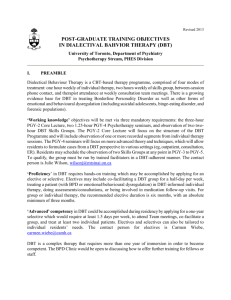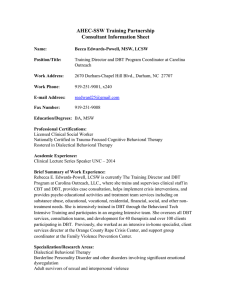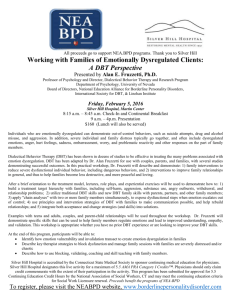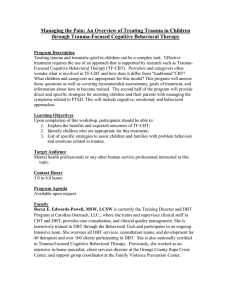Breast Tomosynthesis Bob Liu, Ph.D. Department of Radiology Massachusetts General Hospital
advertisement
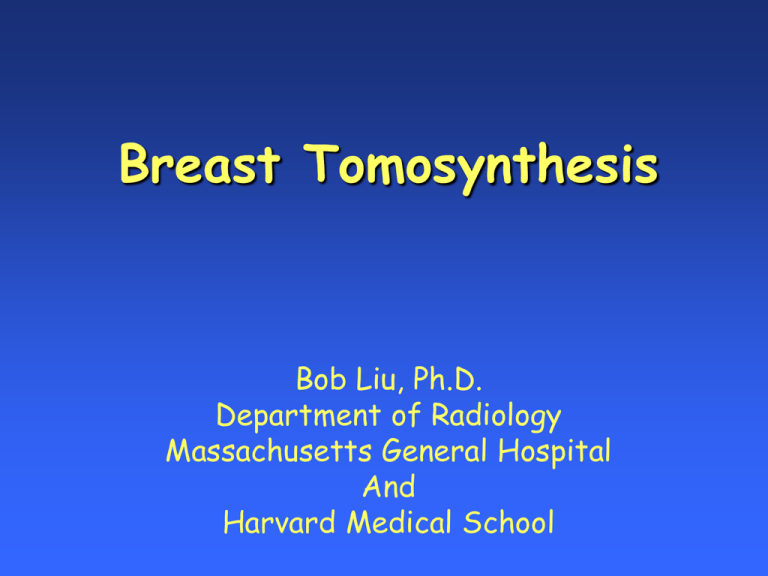
Breast Tomosynthesis Bob Liu, Ph.D. Department of Radiology Massachusetts General Hospital And Harvard Medical School Outline Physics aspects of breast tomosynthesis Quality control of breast tomosynthesis Limitation of 2D mammography Performance of 2D Mammography Sensitivity: 83.55 Specificity: 90.9% Good but not ideal. The root cause? The radiation dose ? No. wide dose range in use. The detector resolution ? No. SF resolution more than enough. The detector dynamic range? No. SF & DM difference small. The structure noise due to tissue overlaps? Yes Limitation of 2D systems and solutions Effects of structure noise Solution: Tomographic imaging o Digital Breast Tomosyntheisis (DBT) o Breast CT (BCT) o Breast MRI o … For a screening modality, it must be low cost, low dose , fast, efficient … DBT may be the only option Digital Breast Tomosynthesis Scan: N projections New variable affecting IQ o o o o tube/detector/patient motion range of rotation number of projections scatter intensity Reconstruction: M slices New variable affecting IQ o incomplete data in f space o selection of recon kernel o geometric calibration DBT Performance Resolution: x-y plane: <~ DM (motion/pixel binning/geo calibration/recon) z-direction: ~ 1 mm (limited data in f space) Calcification detection: Conflicting reports (DBT better if no detector pixel binning) 2D image is required for Hologic for better cal. visualization Mass detection: sensitivity and specificity improved, recall rate dropped DBT Performance Artifacts: High density objects in multiple slices (due to limited sampling) Dose (ACR phantom, Hologic DBT): Combo (DBT+2D) acquisition: DBT acquisition with synthetic 2D: Workflow: ~ DM, reading time longer Cost: ~ 2 x DM + cost for more storage ~ 2.2 x DM ~ 1.2 x DM Characteristics of DBT Systems GE Essential Hologic Selenia IMS Giotto Planmed Siemens Philips Dimensions TOMO Nuance Excel MAMMOMA MicroDose DBT T Inspiration X-ray tube target Mo/Rh W W W W W X-ray tube filters Mo/Rh Al Rh/Ag Rh/Ag Rh Al Step&shoot Continuous Step&shoot Continuous Detect type CsI-Si a-Se a-Se Csi-a-Si a-Se Si, photon C Detector size (cm) 24x30 24x29 24x30 24x30 24x30 21-slit Detector pixel (µm) Detector motion 100 Static 70/140 Rotating 85 Static 85 Rotating 85 Static 50 Rotating Air gap (cm) Grid 2.2 Trial 2.5 None 2.2 None 2.38 None 1.7 None 0.4-2.4 None Angular range (deg) 25 15 40 30 50 11 Number of projections Scan time (s) 5 7 15 3.7 13 12 15 20 25 25 21 3 - 10 X-Ray Tube motion Continuous Continuous Optimization of DBT System Phantoms: o Uniform background with embedded features (ACR) o Anthropomorphic phantom ( CIRS ) o Mathematic phantom Figure of Merit (FOM): o MTF/DQE o CNR, CNR/MGD, CNR/ASFw o Signal difference noise ratio (SDNR) Optimization of DBT X-Ray sources: oTarget: Mo/Rh/W, more systems with W o Filter: Mo/Rh/Ag/Al o kVp: up to 49 (> DM ) High output is desirable for short acquisition time and contrast is enhanced by structure noise reduction, for same breast thickness, higher kVp is used in DBT X-Ray Detectors: o Material: CsI-Si (indirect), a-Se (direct) o Minimal lag and ghosting o Fast reading time o May be running in the binning mode to speed up data acquisition X-Ray Grid o Not use with most DBT, GE is developing one for DPT o Primary ray may be cutoff o Dose may be double Optimization of DBT X-Ray tube motion: Step-and-Shoot: Continuous: no focal spot motion blurring, but longer t focal spot motion blurring, but short t Angular range: α o Large α −> better z-resolution, o Large incident angle-> lower detector MTF and DQE for high f signal o Large incident angle-> more attenuation o Optimal: 45 – 60 degree # of projections: N o For fixed α , IQ improves as N increases until N reaches a certain # o High N -> higher noise in projection images o optimal: 15-20 QC of DBT System There is no QC standard for all DBT systems. Follow Equipment Vendor’s QC manual The Hologic QC manual MAN-01965 covers: -Selenia Dimensions 2D FFDM system -Selenia Dimensions DBT system Selenia Dimensions: Image Acquisition Modes 3 Combo: Tomo + 2D under the same compression 1 2D Only 2 DBT Only ! AEC is calibrated independently for each mode Selenia Dimensions: Specifications DBT Imaging Conventional 2D Imaging • • • • a-Se detector, 24×29 cm area 70 µm pixel size Rh and Ag filters HTC grid in contact mode; No grid in magnification mode • • • • • • • • • a-Se detector, 24×29 cm area 140 µm pixel size (2x2 binning) Al filter No anti-scatter grid Moving tube, 15° sweep Moving detector 15 projections 3-4 seconds acquisition FBP Reconstruction - ~100 µm pixel size - 1 mm slice spacing Approved screening protocol for each breast: One CC view DBT and one CC view 2D One MLO view DBT and one MLO view 2D Selenia Dimensions QC Tests (MP) Quality Control Test 2D 3D Mammographic Unit Assembly Evaluation Yes Collimation Assessment Yes Yes Artifact Evaluation Yes Yes kVp Accuracy and Reproducibility Yes Beam Quality Assessment — HVL Yes Yes Evaluation of System Resolution Yes Yes Automatic Exposure Control (AEC) Function Performance Yes Yes Entrance Exposure, AEC Reproducibility, and Dose Yes Yes Radiation Output Rate Yes Phantom Image Quality Evaluation Yes Signal-To-Noise and Contrast-To-Noise Measurements Yes Diagnostic Review Workstation Quality Control Yes Detector Ghosting (Troubleshooting Use Only) Yes Yes FDA approved screening protocol For each breast: One CC view DBT One CC view 2D One MLO view DBT One MLO view 2D 2D image can be acquired o o In the combo mode Generated from DBT images with C-view software QC Test: Dose Objective: To assess ESE and AGD Test Method o Measured ESE of ACR phantom in 2D or DBT or combo mode o Calculate AGD using the ESE to AGD tables in the manual Performance criteria: 2D: DBT: Combo: AGD < 3 mGy. AGD < 3 mGy AGD < 3 mGy ( can be very close to 3 mGy!) QC Test: Artifact Evaluation Objective: To assess the degree and the source of artifacts Test Method: oAcquire projection images with 4 cm acrylic block. oCheck artifacts in the 0 degree projection image oArtifacts due to reconstruction is not evaluated Performance criteria: Similar to DM . . QC Test: System Resolution Objective: To assess the limiting spatial resolution of the system Test Method: oAcquire 2D and DPT images of line pair pattern over 4 cm acrylic o Determine the highest frequency line resolved in 2D image o Determine the highest frequency line resolved in focal slice of DBT image set Performance criteria: 2D: 7 lp/mm must be resolved DBT: 3 lp/mm must be resolved. QC Test: Phantom Image Quality Objective: To assess the quality and consistency of images Test Method o Acquire ACR phantom image in Combo or DBT mode o Determine the score of fibers, specks and masses in 2D image o Determine the score of fibers, specks and masses in the focal slice Performance criteria: Passing score: 2D: 5 fibers, 4 speck groups and 4 masses. DBT: 4 fibers, 3 speck groups and 3 masses For Hologic Dimensions DBT, the measured high contrast resolution in reconstructed slices is typically lower than that measured in 2D mode. Which one of the followings is not the possible reason? 0% 0% 0% 0% 0% 1. 2. 3. 4. 5. X-ray source motion Patient motion Detector pixel binning Al filter used in tomo mode Inaccurate geometric calibration 10 Answer: 4. Al filter used in tomo mode Explanation: The filter will change the shape of x-ray spectrum, may affect HVL, dose and contrast, but not affect system resolution. Reference: 1. J. A. Baker and J. Y. Lo, “Breast tomosynthesis: State-of-the-art and review of the literature,” Acad. Radio l. 18, 1298–1310 (2011). For fixed angle range and total mAs, too many projections may degrade the image quality, because 0% 0% 0% 0% 0% 1. 2. 3. 4. 5. Too many points will be in frequency space Acquisition time will be longer Dose will be higher Projection image will be very noisy X-ray tube will be too hot 10 Answer: 4 Projection image will be very noisy Explanation: If there are too many projections, mAs for each proje ction can be very low, the projection image will be very noise. Reference: Sechopoulos I., A review of breast tomosynthesis. Part I. The image acquisition process. Med Phys. 2013 Jan;40(1) For Hologic Dimensions, the total mean glandular dose to ACR mammographic Accreditation phantom in the combo mode (2D+DBT) must not exceed 0% 0% 0% 0% 0% 1. 2. 3. 4. 5. 6 mGy 3 mGy 4.5 mGy 2.5 mGy 3.5 mGy 10 Answer: 2 3 mGy Explanation: Specified in Selenia Dimensions QC manual Reference: Selenia Dimensions QC Manual MAN-01965,rev. 007 page 44 Other Optional Tests Ghosting Artifacts for reconstructed images Z-resolution … Thank You !


